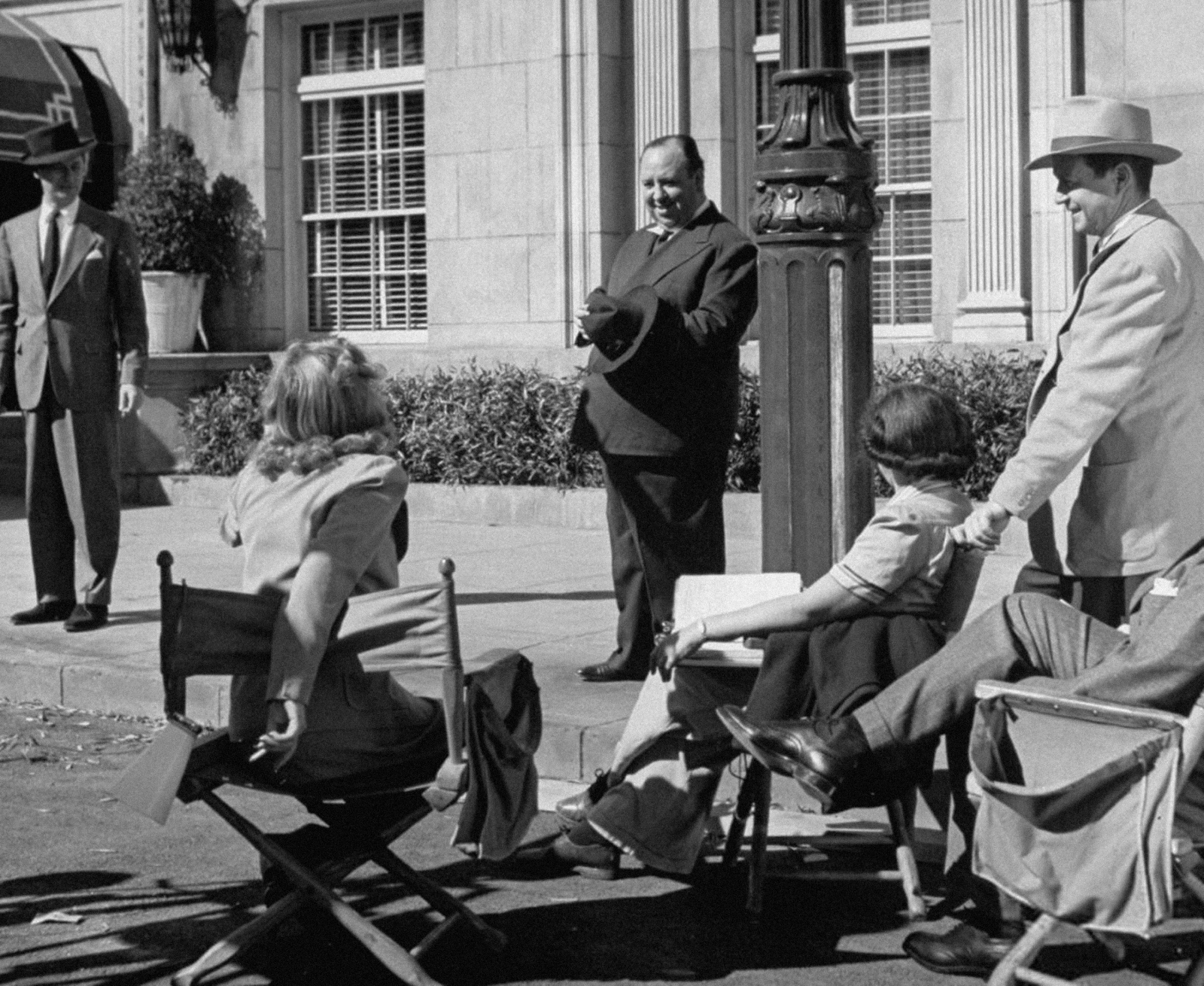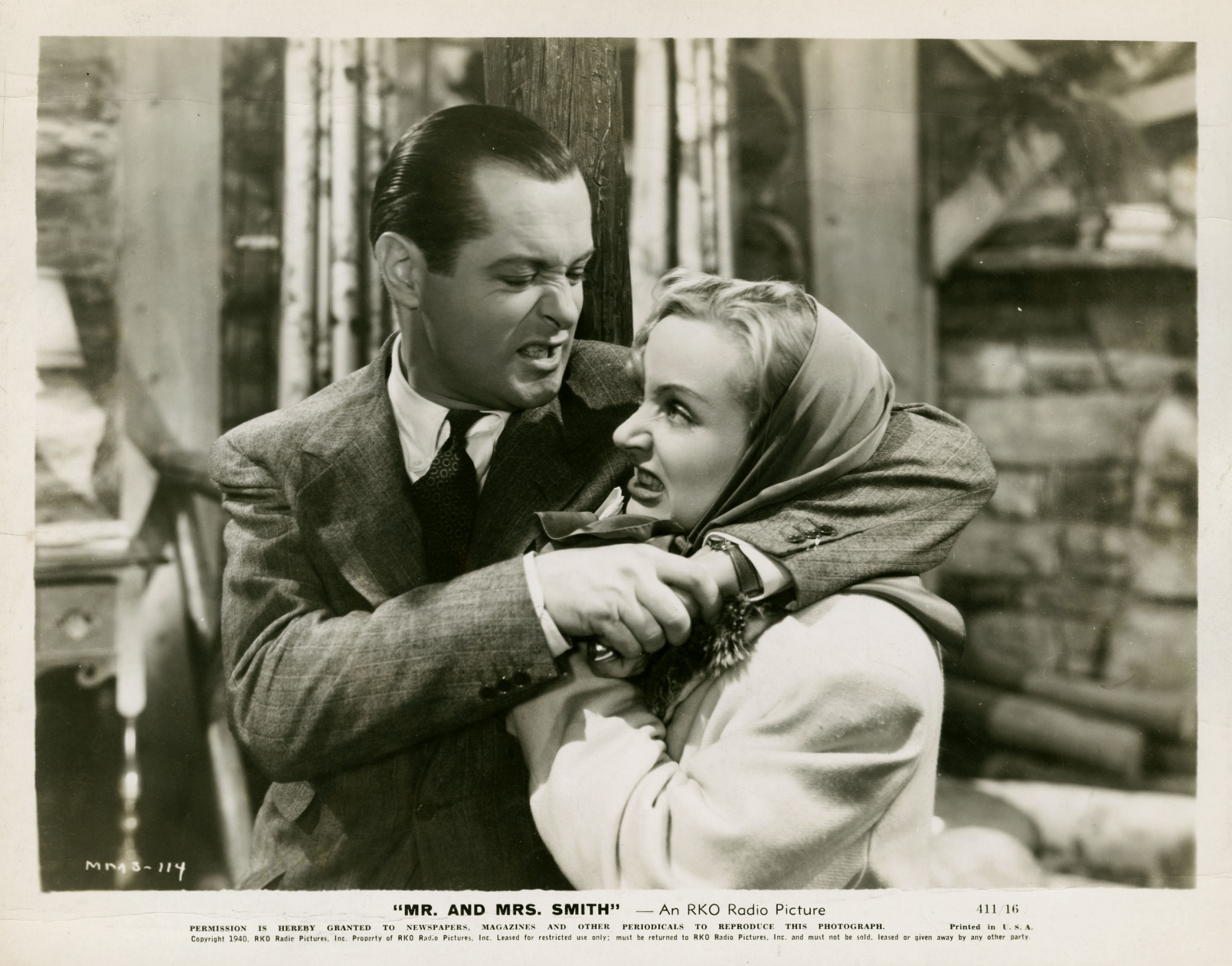- Quintessential screwball comedy which, contrary to popular belief, Hitch actually chose to direct
- Shining star: Poignantly showcases mercurial actress Carole Lombard in her penultimate role
- Two decades after her tragic death, Hitch unfairly disavowed it and yet again rewrote history
- Underrated and overlooked: Has unfairly fallen through the cracks of its makers’ stellar CVs
Note: this is part of an ongoing series of 150-odd Hitchcock articles; any dead links are to those not yet published. Subscribe to the email list to be notified when new ones appear.
Mr. & Mrs. Smith, Part 2: Home video and remakes

US insert poster
Contents
Synopsis
New trailer | clips, cat
A complete change of pace for the legendary director Alfred Hitchcock, this zany screwball comedy is a madcap, fast-paced farce starring Carole Lombard and Robert Montgomery. A young couple discover their marriage is void because of a legal hitch having to do with state borders. As a result, they separate and give single life a go to celebrate their new found “freedom.” Mr. Smith is somewhat reluctant about this plan but plays along in hopes of winning Mrs. Smith back. A fun-loving marriage is suddenly over because of a technicality and only true love or madness can save them! from an original Norman Krasna script comes an enlivened romantic comedy stunningly captured by Hitchcock’s lens. – US Image VHS and LD (1989)
Lombard and Montgomery get hitched as they’re getting unhitched!
“If you had it all to do over again. would you have married me?” Yes, guys, there is a right answer. That’s something David Smith learns the hard way when bubbly better-half Ann queries him over breakfast. Also right are radiant Carole Lombard and easygoing Robert Montgomery as the stars of this breezy Alfred Hitchcock comedy. For three years, the Smiths have been blissed but battling. But when a technicality voids their union, Mr. misses Mrs., orbiting the tale into the delightful cockamamie of the screwball genre. From a script by Academy Award winner Norman Krasna, Hitchcock made his change-of-pace foray into all-out humor memorable. “Here again are his unmistakable touches,” Look declared. “The net effect is the same, too: another Alfred Hitchcock hit.” – US Warner VHS and DVD (1999/2004)
Review
That’s Simple As ABC ad, Hollywood | Lombard Is At It Again!/ad, from? | Filmprogramm Nr. 73, Illustrierter Film-Kurier
Smith Family Slapstick: Lombard-Montgomery Comedy Upholds Marriage Rows
Since his arrival in Hollywood from England more than a year ago, Alfred Hitchcock, the roly-poly dean of cinematic melodrama, has turned out two smash hits: Rebecca and Foreign Correspondent. Now, with Mr. & Mrs. Smith, the English director tries his hand at farce. While the more ardent of Hitchcock’s admirers will be disappointed to find him less deft with laughs than thrills, this RKO Radio comedy is extremely funny in spots.
To a great degree the film’s gaiety is due to the fact that Carole Lombard and Robert Montgomery are at their comic best impersonating the fabulous Smiths. Along with other eccentricities, the Smiths have Marquess of Queensberry rules for marital crises, chief of which is an agreement that requires the combatants, following a quarrel, to remain barricaded in their bedroom until the aggressor has muttered a mea culpa and been forgiven. While these boudoir sitzkriegs have sometimes lasted for eight days, they have been generally satisfactory (overlooking that slight scar on Mr. Smith’s forehead).

The Smiths of Hollywood: Montgomery and Lombard stage a lovers’ quarrel that lasts three years (alt, Swedish DVD artwork)
Mr. Smith, we are informed, is a brilliant young lawyer, but what with one thing and another, he doesn’t seem to get to his office very often—particularly after it turns out that the Smiths’ three-year marriage is technically void, and Mrs. Smith, impulsive to the last, locks him out of the house. What little plot Norman Krasna manages in his flippant script centers around Mr. Smith’s attempts to get back in again (object matrimony, of course), and the unexpected emergence of his placid law partner (Gene Raymond) as a rival for Mrs. Smith’s affection.
At its best the Krasna plot offers nothing you haven’t seen before, but at its worst only a few sequences can be accused of irrelevance and dullness. For the rest, Hitchcock, deprived of murder and mayhem, keeps a lightweight romance spinning along with a lively alternation of subtlety and slapstick. Filmgoers who don’t recognize Mr. Smith’s law partner immediately should remember that when Gene Raymond attempted a screen comeback in Cross-Country Romance (Newsweek, July 8, 1940), his first move was to tone down his spectacular platinum waves. This time there are no halfway measures. Currently, Gene Raymond is unequivocably a brunette, with the last reluctant wave flattened into slick submission. Possibly as a direct result, the actor turns in his most ingratiating performance to date. – Newsweek
Old reviews: Gazette, Harrison’s, Hollywood, Hollywood Reporter, Look, NY Times, Tribune/pic, Variety | new: Globe
Production
Here at their peak, Lombard and Montgomery may play the titular couple but further down the cast list you’ll find Betty Compson, doyenne of the silent era and early talkies. As a star import, she led two British films Hitch worked on at the beginning of his career, Woman to Woman and The White Shadow, and appeared in a third, The Prude’s Fall. But here, her star’s on the wane and, now mostly limited to featuring in B-movies, she appears in her last significant screen outing.
This also turned out to be Lombard’s penultimate film, owing to her tragic early death less than a year after its release. Her last, Lubitsch’s iconic satire To Be or Not to Be, was released posthumously. Amazingly, despite the abundance of books on the star, there are just two half-hour documentaries dedicated to her, both French from 1997 and 2004, but at least their respective clip and DVD have English subtitle and soundtrack options.
- France: RDM DVD Couples & duos : Carole Lombard & Clark Gable (2004)
Hitch is infamous for regularly fibbing in interviews, which has created endless headaches for historians and anyone wanting to document the truth. In this case, he told François Truffaut that he only did the film as a favour to Lombard, whereas RKO studio records show Hitch had long wanted to direct her and for various reasons actively pursued the project himself; if anything, she did a favour for him. Talk about self-mythologising. But in this case it’s an especially distasteful example, given that Lombard was no longer around to defend herself or refute Hitch’s claims. The earliest I’ve traced his assertion back to is Truffaut’s initial 1962 interviews, when Hitch presumably felt sufficient time had passed to start rewriting that particular piece of history. All other sources appear to quote from there:
“That picture was done as a friendly gesture to Carole Lombard. At the time, she was married to Clark Gable, and she asked whether I’d do a picture with her. In a weak moment I accepted, and I more or less followed Norman Krasna’s screenplay. Since I really didn’t understand the type of people who were portrayed in the film, all I did was to photograph the scenes as written.”

Watch your back, Carole… Lombard ‘directs’ Hitch in a cameo staged for the press and filmed for an MIA short subject, which is quite unlike his actual appearance in the film.
Incidentally, when the Hitchcocks emigrated to America in early 1939, initially producer David O. Selznick rented the family a three-bedroom apartment in the Wilshire Palms building at 10331 Wilshire Boulevard, now since demolished. Hitch then took on the lease of Carole Lombard’s old Bel Air home from October 1939 but apparently didn’t feel comfortable staying there after her untimely death in January 1942. (Presumably his discomfort had eased sufficiently 20 years later for him to begin publicly airing his not-so subtle slights.) Within a few months, the Hitchcocks bought a brand new house just two miles away and lived there for the rest of their lives.
Alma Reville died in 1982 and it was sold the following year to a businessman who had it extensively remodelled. He and his wife owned it for another 40 years, and when they too died it went on the market in 2023, quickly selling for $8.8m to a “Dutch soap opera star”. What’s most surprising is how, for such a large and expensive property, it has no real garden to speak of but is closely hemmed in by hedges on all sides. Aerial photos indicate it never had any spare land in the first place but at least adjoins the Bel Air Country Club golf course. Also, let’s not forget that from 1940–1974 the Hitchcocks owned a weekend retreat in the form of a 200-acre estate in the Santa Cruz mountains.
Life Movie of the Week | Showmen’s Trade Review/campaign | pressbook/alt | Motion Picture Herald

Wedded blitz: The Smiths battle it out in Hitch’s only screwball comedy, in which Cary Grant was originally slated to star.
- Mixed Romances: Mr and Mrs Smith – Lesley Brill, The Hitchcock Romance: Love and Irony in H’s Films (1988)
Mr. & Mrs. Smith is one of the most noteworthy examples of screwball trope the comedy of remarriage. It’s often incorrectly referred to as Hitch’s only comedy, when several unstintingly humorous British films such as The Farmer’s Wife, Champagne, thriller spoof Number Seventeen and the co-directed Elstree Calling give the lie to that statement. Indeed, every film he made was either a black comedy – even, by his own reckoning, Psycho – or at least had strong comedic elements. It would be more accurate to describe Mr. & Mrs. Smith as “Hitchcock’s only American comedy in which no one dies or is at risk of serious harm.” But that isn’t nearly as catchy, is it? Incidentally, the script originally called for the sound of a flushing toilet, predating Psycho by almost two decades, but even one heard and not seen was too much for the censors, so it was nixed in favour of clanging pipes.
Overall, it may be said the film itself unfairly doesn’t loom large in Hitch’s filmography and, according to musicologist Paul Ackerley, that certainly applies to its “largely overlooked score, credited to seven-Oscar-nominated Edward Ward with an uncredited Roy Webb as musical director – though he’s very much credited with the excellent score for Notorious. It’s an appropriately perky score, with a very distinctive-cum-irritating recorder motif, cued in whenever Montgomery and Lombard’s characters are at their most tiresome, which is often. Hitch’s sound design requirements were so exacting it’s very likely that it works only because of its precise alignment with the emotional state of the leads.”
Mr. and Mrs. Smith: Hitchcock’s Experiment in Screwball Comedy – William Covey

Spanish poster, retooled for various streaming services with non-American prints
Related articles
This is part of a unique, in-depth series of 150-odd Hitchcock articles.
